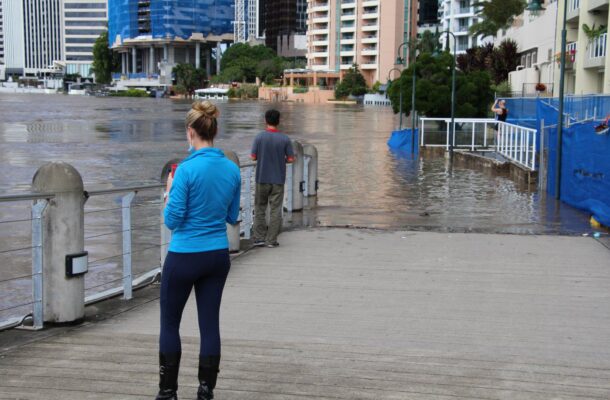After the flood

Building back smarter from floods is about more than infrastructure. As Australia is finding out, improvements to healthcare are key to the solution.
In the aftermath of the devastating floods that hit eastern Australia in early 2022, affected residents were left with serious questions about the country’s resilience to intensifying extreme weather events and the institutions tasked with mopping up afterwards.
Floods in Australia are expected to happen more often, for longer, and with more intensity, owing to climate change. It is a matter of when, not if, the next destructive flood hits — and lives depend on strengthening the long-term resilience of health and social services across the country.
The 2022 floods across areas of New South Wales and south-east Queensland brought death, housing and infrastructure damage, and disruptions to healthcare and other important services. Flooding can kill through drowning, injuries, poisonings and infections.
But the visible, immediate effects that make the headlines are only a fraction of the overall health burden of floods. People affected by floods can experience long-lasting mental health conditions, such as depression, anxiety and post-traumatic stress disorder. The problem is even more pronounced for vulnerable groups with existing health inequalities, such as people with disabilities, First Nations people, and socio-economically disadvantaged communities.
In the view of the Intergovernmental Panel on Climate Change (IPPC), which flagged it as a key risk in their 2022 report, Australia’s institutions are presently unable to properly manage climate challenges. Time is of the essence to improving resilience to flooding, particularly in the health sector. The IPCC report offered a good starting point: emphasising the value of tapping into a diverse knowledge base — scientific, local and Indigenous — to help communities adapt to climate change.
Building flood resilience involves questions of engineering: rebuilding infrastructure in smarter ways and strengthening flood defences. But comprehensive flood protection demands a willingness to adopt fundamental changes: a reorganisation of community, health and the economy. In Australia, that means major investment in disaster management, and meaningful engagement with rural health services and First Nations communities.
This all-in response isn’t just prompted by floods. The converging hazards of climate change (and disasters that result), rising obesity, and the COVID-19 pandemic are ripping open the cracks that are exposed by socio-economic inequalities, an ageing population, and unchecked urban sprawl.
To rein in this trend, the government will have to ramp up their focus in many areas: planning land use through the lens of climate and flood resilience, lifting housing conditions, providing high-value health care, strengthening public health surveillance and emergency warning systems, and fostering a circular economy that will enable the transition towards net zero.
Specifically, the health sector could use the moment of reconfiguration to zero in on chronic disease prevention, structural and operational resilience improvements, and reducing clinical waste, transport, water and energy.
None of these transformations are simple, but the window is still open to start the work. The health sector has the opportunity to be part of the solution to flood devastation across all phases of disaster management, from prevention to preparedness to response and recovery.
Flood preparedness and recovery plans should be developed in partnership with health and emergency services, disability organisations and community groups, including Aboriginal and Torres Strait Islander communities, to ensure that scientific knowledge is combined with local knowledge gained from practical experience and built from the ground up.
This article was written by Sotiris Vardoulakis, a Professor of Global Environmental Health at the Australian National University; Veronica Matthews, a Senior Research Fellow at the University Centre for Rural Health at the University of Sydney;and Ross Bailie, a Professor of Rural Health with Sydney Medical School.
Originally published under Creative Commons by 360info™.
Veronica Matthews heads the Centre for Research Excellence, an Indigenous-led collaboration strengthening systems to improve primary health care and the social and cultural determinants of wellbeing.














